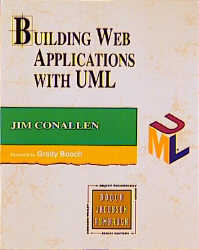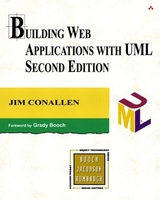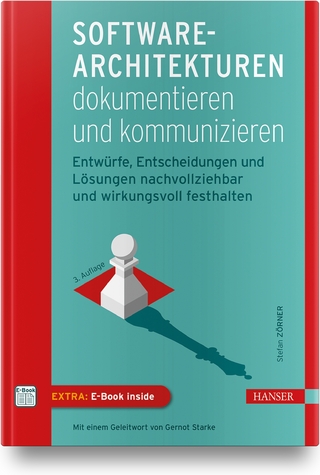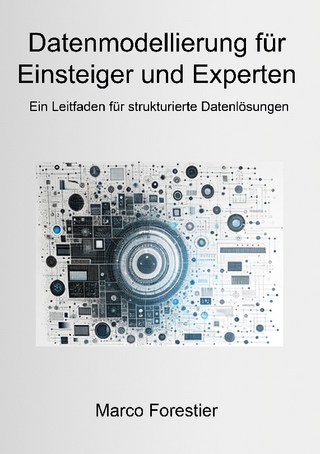
Building Web Applications with UML
Addison Wesley (Verlag)
978-0-201-61577-7 (ISBN)
- Titel erscheint in neuer Auflage
- Artikel merken
Building Web Applications with UML is a guide to building robust, scalable, and feature-rich web applications using proven object-oriented techniques. Written for the project manager, architect, analyst, designer, and programmer of web applications, this book examines the unique aspects of modeling web applications with the Web Application Extension (WAE) for the Unified Modeling Language (UML). The UML has been widely accepted as the standard modeling language for software systems, and as a result is often the best option for modeling web application designs. The WAE extends the UML notation with semantics and constraints enabling developers to model web-specific architectural elements using the Rational Unified Process or an alternative methodology. Using UML allows developers to model their web applications as a part of the complete system and the business logic that must be reflected in the application. Readers will gain not only an understanding of the modeling process, but also the ability to map models directly into code.
Key topics include: *A basic introduction to web servers, browsers, HTTP, and HTML *Gathering requirements and defining the system's use cases *Transforming requirements into a model and then a design that maps directly into components of the system *Defining the architecture of a web application with an examination of three architectural patterns describing architectures for thin web client, thick web client, and web delivery designs *Modeling, at the appropriate level of abstraction and detail, the appropriate artifacts, including web application pages, page relationships, navigate routes, client-side scripts, and server-side generation *Creating code from UML models using ASP and VBScript *Client-side scripting using DHTML, Java Script, VBScript, Applets, ActiveX controls, and DOM *Using client/server protocols including DCOM, CORBA/IIOP, and Java's RMI *Securing a web application with SET, SSL, PGP, Certificates, and Certificate Authorities 0201615770B04062001
Jim Conallen is the Web Modeling Evangelist at Rational Software Corporation, where he has continued his work on the development of the Web Application Extension for the Unified Modeling Language. Prior to joining Rational, he was a consultant specializing in full life cycle object-oriented development. He has built client/server and web-based systems in the transportation, telecommunications, and health care domains; has architected large, high-volume transaction processing systems; and has designed and developed applications in C++, Smalltalk, Java, Delphi and Visual Basic. Jim is a frequent speaker on topics ranging from web application modeling to software best practices. He has written for many industry publications, including ASPToday.com, Rose Architect, and Communications of the ACM. 0201615770AB06262002
(Each chapter concludes with a chapter summary.)I. INTRODUCTION AND SUMMARY OF WEB-RELATED TECHNOLOGIES.
1. Introduction.
What Is This Book?
Who Should Read This Book?
Book Organization.
2. Web Application Basics.
HTTP.
HTML.
Anchors.
Forms.
Frames.
Web Applications.
Session Management.
Enabling Technologies.
3. Dynamic Clients.
Document Object Model.
Scripting.
JavaScript Objects.
Custom JavaScript Objects.
Events.
Java Applets and Beans.
ActiveX/COM.
Summary.
4. Beyond HTTP and HTML.
Distributed Objects.
RMI.
CORBA.
DCOM.
XML.
5. Security.
Types of Security Risks.
Technical Risk.
Server-Side Risks.
Client-Side Risks.
Security Strategies.
Encryption.
Best Practices.
II. BUILDING WEB APPLICATIONS.
6. The Process.
The Model.
Workflows.
Project Management.
Requirements Gathering.
Analysis.
Design.
Implementation.
Test.
Deployment.
Configuration and Change Management.
Risk.
Iteration.
7. Defining the Architecture.
Examining the Use Cases.
Web Application Architecture Patterns.
Thin Web Client.
Thick Web Client.
Dynamics.
Web Delivery.
8. Requirements and Use Cases.
Requirements.
Gathering Requirements.
Guidelines for Writing Good Requirements.
Prioritization.
Use Cases.
9. Analysis.
Iteration.
Packages.
Defining the Top-Level Model.
Analysis.
Sequence Diagrams.
Collaboration Diagrams.
Activity Diagrams.
10. Design.
UML Extension for Web Applications.
Designing Web Applications.
Partitioning Objects for Thick Web Client Web Applications.
Partitioning Objects for Web Delivery Web Applications.
Elaborating the Design with Sequence Diagrams.
Thin Web Client Design.
Server Pages.
Links.
Forms.
Frames.
Thick Web Client Design.
Web Delivery Design.
DCOM.
RMI/IIOP.
Guidelines for Web Application Design.
11. Implementation.
Server Pages.
Client Pages.
Links.
Frames.
Client Side-Objects.
Server Side Includes.
Appendices.
Appendix A: Web Application Extension for UML.
Description.
Prerequisite Extensions.
Stereotypes.
Well-Formedness Rules.
Comments.
Appendix B: An E-Commerce Use Case ExampleUse Case.
Specification: Browse Catalog.
1. Browse Catalog.
1.1 Goal.
1.2 Brief Description.
2. Flow of Events.
2.1 Basic Flow.
2.2 Alternative Flows.
3. Preconditions.
3.1 Internet Access.
3.2 HTML 3.2-Compliant Browser.
4. Extension Points.
4.1 Add Item to Shopping Cart.
4.2 Checkout Shopping Cart. Appendix C: Glossary ASP Application Sample Model.
Vision Statement.
Top-Level Use Case View.
Analysis Model: Main Diagram.
Analysis Model: Use Case Sequence Diagrams.
Browse Glossary Main Sequence Diagram.
Search Glossary Main Sequence Diagram.
Edit Glossary Sequence Diagram for Entry Use Case.
Design Model.
Top Level Class Diagram.
Use Case Realizations.
Top-Level Logical View.
Server Components Package: Main Class Diagram.
Web Pages Package.
Component View.
Source Code (after implementation).
GlossaryHome.htm.
GetEntries.asp.
ProcessSearch.asp.
EditEntry.asp.
UpdateEntry.asp.
string-util.asp.
ErrorMsg.asp.
global.asa.
Appendix D: Roses Alive! Project Plan Outline.
Iteration 1: Getting started.
Iteration 2: Elaboration of the Vision.
Iteration 3: Realizing Use Cases.
Iteration 4: First Real Executables.
Iteration 5: The System Comes to Life.
Iteration 5: The System Continues to Evolve.
Iteration 5-6: Beta Releases and Updates.
Iteration 7: Initial System Release.
Appendix E: Sample Rational Rose Scripts.
ASPTool.
MakeASPComponents.
Index. 0201615770T04062001
| Erscheint lt. Verlag | 22.12.1999 |
|---|---|
| Verlagsort | Boston |
| Sprache | englisch |
| Maße | 185 x 235 mm |
| Gewicht | 481 g |
| Themenwelt | Mathematik / Informatik ► Informatik ► Datenbanken |
| Informatik ► Software Entwicklung ► UML | |
| Mathematik / Informatik ► Informatik ► Web / Internet | |
| ISBN-10 | 0-201-61577-0 / 0201615770 |
| ISBN-13 | 978-0-201-61577-7 / 9780201615777 |
| Zustand | Neuware |
| Haben Sie eine Frage zum Produkt? |
aus dem Bereich



